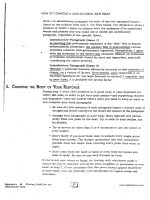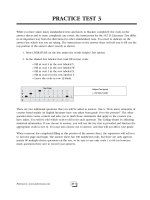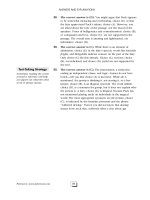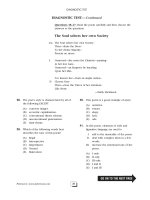SAT II Physics (Gary Graff) Episode 1 Part 3 doc
Bạn đang xem bản rút gọn của tài liệu. Xem và tải ngay bản đầy đủ của tài liệu tại đây (209.91 KB, 25 trang )
Chapter 1
PRELIMINPRELIMIN
PRELIMINPRELIMIN
PRELIMIN
ARAR
ARAR
AR
Y CONCEPTSY CONCEPTS
Y CONCEPTSY CONCEPTS
Y CONCEPTS
Peterson’s: www.petersons.com 47
CHAPTER 1
PRELIMINPRELIMIN
PRELIMINPRELIMIN
PRELIMIN
ARAR
ARAR
AR
Y CONCEPTSY CONCEPTS
Y CONCEPTSY CONCEPTS
Y CONCEPTS
SIMPLE EQUASIMPLE EQUA
SIMPLE EQUASIMPLE EQUA
SIMPLE EQUA
TIONS AND ALGEBRATIONS AND ALGEBRA
TIONS AND ALGEBRATIONS AND ALGEBRA
TIONS AND ALGEBRA
Physics is the branch of science that studies physical phenomena.
Why does the sound of a starter’s pistol reach an observer standing at
the race finish line after the puff of smoke is seen when the gun is
fired? Why do some objects float in water, while other objects sink?
What causes a ball to roll downhill?
These questions and more are the stuff of physics. Sometimes the
study of physical phenomena involves observation, experimentation,
and calculation. The calculations used in this review are accomplished
by using a little algebra, a little geometry, and a little trigonometry.
Many relationships in physics can be expressed as equations. For
example:
F = ma
s = vt
Sometimes the value to be found is not by itself (isolated) in the
equation. Take, for example, the linear motion equation:
V
f
2
= V
0
2
+ 2as
Let’s suppose the acceleration a is the only unknown quantity in
the equation. We must perform a little algebraic manipulation to
isolate a so that it is the only quantity on its side of the equal sign.
Before starting the process, remember one simple rule: whatever
operation you perform on one side of the equal sign, you must also
perform on the other side of the equal sign.
Let’s begin by isolating a in the equation below:
V
f
2
= V
0
2
+ 2as
We then subtract V
o
2
from both sides:
V
f
2
–V
o
2
= V
o
2
–V
o
2
+ 2as
Peterson’s SAT II Success: Physics
48
This leads to:
V
f
2
– V
o
2
= 2as
Then we divide both sides by 2s:
VV
s
as
s
f
2
0
2
2
2
2
−
=
Clearing fractions gives:
VV
s
a
f
2
0
2
2
−
=
If you find this algebra to be difficult, you might need to stop
here and review your math skills before proceeding.
GRAPHS
Some relationships studied in physics exist between experimental
values. The relationships between these quantities can be shown using
a technique called
gg
gg
g
rr
rr
r
aphingaphing
aphingaphing
aphing. With this technique, one quantity (the
independent variable) is carefully controlled, while the other quantity
(the dependent variable) is measured at each value of the independent
variable.
The independent variable is plotted along the x axis of the graph,
and the dependent variable is plotted along the y axis of the graph.
The slope for the graph is calculated by dividing the
∆Y
by the
∆X
.
Slope
y
x
=
∆
∆
A graph is a picture of the relationship between two or more
quantities. A direct relationship is one in which both quantities
increase (or decrease) in the same manner. In an inverse relationship,
one quantity increases and the other decreases. A parabolic relation-
ship exists when one quantity varies as the square of the other.
CHAPTER 1
Peterson’s: www.petersons.com 49
DIRECT RELATIONSHIP
GRAPH A
Graph A shows a linear relationship between x and y. For every 2
units’ increase in variable x, variable y increases by 1 unit. The slope
of the graph is calculated as rise over run.
GRAPHS
Peterson’s SAT II Success: Physics
50
INVERSE RELATIONSHIP
GRAPH B
Graph B shows an indirect linear relationship between x and y.
CHAPTER 1
Peterson’s: www.petersons.com 51
PARABOLIC RELATIONSHIP
GRAPH C
Graph C shows a parabolic relationship between x and y.
The ability to read a graph is crucial. They are used to display and
compare physical concepts. Be sure you can read and evaluate
graphs.
GRAPHS
Peterson’s SAT II Success: Physics
52
RIGHT TRIANGLES
Any triangle with a 90° internal angle is defined as a right triangle. In
such a triangle, the remaining two internal angles of the right triangle
sum to an additional 90°. If you are sure you are dealing with a right
triangle, the
Pythagorean theoremPythagorean theorem
Pythagorean theoremPythagorean theorem
Pythagorean theorem becomes a useful tool when
trying to find one of the sides.
The right triangle above is labeled according to convention. The
side opposite the 90° angle is called the hypotenuse and is labeled c.
The side beside the smaller of the remaining two angles is called the
adjacent side b, and the side across from the smaller angle is called
the opposite side a.
The Pythagorean theorem is stated mathematically as
c
2
= a
2
+ b
2
. Thus, should we know the size of any two sides, we can
find the missing side.
Side
Side
Side
cab
acb
bca
=+
=−
=−
22
22
22
Right triangles have special relationships not only with their
sides but also with their internal angles. For every right triangle, the
sides of that triangle and the internal angles of that triangle form a
ratio.
CHAPTER 1
Peterson’s: www.petersons.com 53
These are given as:
sine or sin
cosine
θθ
θ
==
=
opposite
hypotenuse
a
c
adjacent
hypot
eenuse
b
c
opposite
adjacent
a
b
or cos
tangent or tan
θ
θθ
=
==
Further, no matter how long the sides of the triangle may be, the
ratio between the three sides remains the same as long as the internal
angle remains the same.
Triangles 1, 2, 3, and 4 above all have an internal angle of 30°.
Thus the sine, cosine, and tangent values are the same in all four
triangles.
CARTESIAN COORDINATES
The construction and use of right triangles is a valuable tool in
solving physics problems. Unfortunately, not all measures and quanti-
ties begin neatly at zero. Rather than allow this to complicate mat-
ters, we simplify by using the
Cartesian Coordinate SystemCartesian Coordinate System
Cartesian Coordinate SystemCartesian Coordinate System
Cartesian Coordinate System in
conjunction with triangles. You may also recognize this as the four
quadrant x and y system.
RIGHT TRIANGLES
Peterson’s SAT II Success: Physics
54
• The region between the x and y coordinates on the upper right is
called the first quadrant. All x and y quantities in the first quadrant
are positive.
• The region between the x and y coordinates on the upper left is
called the second quadrant. All x quantities in the second quadrant
are negative, and all y quantities in the second quadrant are posi-
tive.
• The region between the x and y coordinates on the lower left is
called the third quadrant. All x and y quantities in the third quad-
rant are negative.
• The region between the x and y coordinates on the lower right is
called the fourth quadrant. All x quantities in the fourth quadrant
are positive and all y quantities in the fourth quadrant are negative.
Quadrant
I
II
III
IV
X coordinate
+x
x
x
+x
Y coordinate
+y
+y
y
y
CHAPTER 1
Peterson’s: www.petersons.com 55
Situations where the Cartesian Coordinate System is used con-
ventionally follow the x, y system for labeling purposes. When a right
triangle is placed within the coordinate system, its sides can be
renamed as follows:
Thus, we could look at the trigonometry functions for a right
triangle that has been placed into the coordinate system as:
sin changes to sin
cos changes to cos
ta
θθ
θθ
=→=
=→=
a
c
y
r
b
c
x
r
nn changes to cos θθ=→=
a
b
y
x
The conventional a, b, c labeling is changed to represent the
physics application, thus becoming x, y, r, where r is the hypotenuse.
The Pythagorean Theorem now looks like this:
Conventional labeling becomes coordinate system labeling.
RIGHT TRIANGLES
Peterson’s SAT II Success: Physics
56
UNITS AND CONVERSIONS
Oftentimes students will be given a value for a physical quantity such
as 50 km/hr
and asked to perform operations that require them to
convert to m/sec. Finding the correct units in this situation means
that you must be able to change kilometers to meters and to change
hours to seconds. Experience has shown most students to be very
capable at performing the mathematic operation. The problem seems
to be one of setting up the conversions between the differing units.
50 km/hr = ? m/sec
One factor that can cause difficulty with conversions is that
many students lack some basic information. You should know in-
stantly that there are 60 seconds in one minute and 3600 seconds in
one hour. The metric units you should know are:
1000 meters = 1 kilometer
100 centimeters = 1 meter
1000 millimeters = 1 meter
Then there are the equivalent values for volume (liters) and mass
(grams) as well. There is a list of constants, equivalents, and physics
formulas on page 15. Be sure you are very familiar with this informa-
tion.
Returning to the conversion mentioned, we begin:
50 km/hr = ? m/sec
There are 1000 meters in a kilometer, thus we multiply 50 km by
1000 m/km, yielding 50,000 meters.
Now we have:
50,000 m/hr = ? m/sec
There are 3600 seconds per hour, thus we multiply one hour by
3600 sec/hr, yielding 3600 seconds.
Divide distance by time for the final value.
50 000
3600
13 88
,
sec
./sec
m
m=
CHAPTER 1
Peterson’s: www.petersons.com 57
The whole conversion can be made into a one-step calculation by
writing each part and solving.
(50 km/hr)(1,000 m/km)
hr
13.88m/sec
1
3600sec
=
During the conversion process it is absolutely essential that you
state and complete your dimensional analysis.
SCALARS AND VECTORS
SCALARS
The treatment of physical quantities is based upon the kind of quan-
tity in question. Two important physical quantities we will study are
scalars and vectors.
Quantities defined strictly by their magnitude are called scalar
quantities. Scalars are easy to recognize: a dozen eggs, a gross of
paper clips, half a dozen apples, a kilogram of cheese. All the stated
quantities denote a number (12, 144, 6, 1) of the item listed, nothing
more.
Therefore, a Sunday drive could easily be described by the
number of miles traveled: “We drove 80 km today.” Should we wish to
add more information, such as where we traveled, then another
physical quantity is used.
VECTORS
Quantities defined both by their magnitude and direction are called
vector quantities. Vectors are also easily recognized, as they must
include both magnitude and direction: four steps to the right, 50
meters south, 9N @ 45º. Taking another look at the Sunday drive
above, we can define it as a vector by saying “We drove 80 km to the
museum and back today.” Vectors are always stated in respect to a
reference point.
SCALARS AND VECTORS
Peterson’s SAT II Success: Physics
58
SOLVING SCALAR AND VECTOR PROBLEMS
Numerical operations with scalars are simply a matter of adding or
subtracting the numbers.
ExampleExample
ExampleExample
Example
We have 9 marbles and find 5 marbles. How many do we now have?
SolutionSolution
SolutionSolution
Solution
9
5
14
marbles
marbles
marbles
()+
As you can see, simply add to perform the operation.
The same operation with vector quantities requires a bit more
thought, as both the magnitude and direction must be included.
We’ll start with a straightforward addition problem.
Example
A student walks 4 blocks east and stops at an ice cream truck. After
purchasing a snow cone, he walks another 10 blocks east. Where is
the student in respect to his starting point?
Solution
4 blocks @ east
(+)10 blocks @ east
14 blocks @ east
The student has walked a total of 14 blocks due east.
As in this example, when two vectors are added together, the
result is conveniently called the resultant vector. The original vectors,
which were added together, are the component vectors.
The problem above shows the nature of vectors. Both magnitude
and direction must be included in operations with vectors.
CHAPTER 1
Peterson’s: www.petersons.com 59
The next problem requires the use of the Pythagorean Theorem
when we add a pair of vectors. We will also use the Cartesian Coordi-
nate System (x and y axis).
Example
A bird is perched in the tree where it has its nest. The bird flies 500 m
due east and lands on the ground in a field where it finds a worm.
When the bird takes off, it is chased by a hawk, so the bird flies 300 m
due north before landing in a tree.
What direction must the bird fly to find its nest, and how far
away is the nest?
Solution
When solving physics problems, always use a convenient method with
which you are comfortable. This is how you should approach any
problem you are solving. A method is suggested below.
1. Draw a diagram (above)
2. Isolate and label the parts of the problem
3. Identify both x and y components
4. Write the equation
5. Solve for the unknown
Let’s place the bird’s starting point at the x, y juncture, which is
also its starting point at the nest. The bird is presently located at the
head of the 300 m north vector.
Before solving the problem, convert the compass values to the
x, y coordinate system. The due east vector is located directly along
the x coordinate, which is 0º. The due north vector is located directly
along the x coordinate, which is 90º.
SCALARS AND VECTORS
Peterson’s SAT II Success: Physics
60
As we inspect the problem it becomes clear that the Pythagorean
Theorem is the best way to solve the problem.
c
2
= a
2
+ b
2
Change to the x, y coordinates and
c
2
= y
2
+ x
2
identify c (the hypotenuse) as the resultant
r
2
= y
2
+ x
2
vector.
r
r
=+
=
()()300 500
583
2
mm
m
This is the magnitude value of the resultant vector. The direction
for the resultant can be found with a little right triangle trigonom-
etry.
tan
tan
tan .
θ
θ
θ
θ
=
=
=
=°
y
x
300
500
6
31
m
m
Thus the resultant vector (where the bird is located in respect to
its starting point) is
583m @ 31°
Recall that the bird wanted to fly back to its nest. It can’t fly at
31° from its current position because that path takes the bird farther
from its nest. The direction we have found must be reversed for the
bird to return to its nest.
The resulting direction is exactly 180° opposite the direction the
bird must fly. Take the resultant vector and add (or subtract) 180°
to
or from the vector’s direction.
180° + 31° = 211°
The bird must fly 583 m @ 211° from its present position to
reach its nest. When this is done, the bird will effectively cancel out
the resultant vector. That’s why its flight will be the equilibrant.
CHAPTER 1
Peterson’s: www.petersons.com 61
An equilibrant vector is a vector that is exactly equal in magni-
tude and opposite in direction from the resultant vector.
Example
Let us look at one more vector problem.
Suppose 4 ropes were used to pull on a stationary object.
• Rope a pulls in a direction of 15° with a force of 25N.
• Rope b pulls in a direction of 215° with a force of 16N.
• Rope c pulls in a direction of 75° with a force of 20N.
• Rope d pulls in a direction of 300° with a force of 30N.
If a single rope were to replace the four ropes, with what force
and in what direction must the rope pull?
Solution
The diagram above allows us to see each vector in relation to all the
other vectors.
We will isolate each vector in its turn and break each one into its
x and y components. Then we can combine all the individual x and y
components to find the resultant vector.
First, check and make sure that when you construct your tri-
angles, the y side of the triangle is the opposite side of the triangle,
and the x side is the adjacent side of the triangle.
SCALARS AND VECTORS
Peterson’s SAT II Success: Physics
62
Rope a extends 15° into the first quadrant.
Side y = Side r (sin 15°) = (30N) (.26) = 7.8N
Side x = Side r (cos 15°) = (30N) (.97) = 29.1N
Both components of rope a are located in the first quadrant.
y
x
positive 7.8N
positive 29.1N
=∴+
=∴+
CHAPTER 1
Peterson’s: www.petersons.com 63
Rope b extends
35° into the third quadrant .
Side y = (side r) (sin 35°) = (16N) (.57) = 9.1N
Side x = (side r) (cos 35°) = (16N) (.82) = 13.1N
Both components of rope b are located in the third quadrant.
y
x
negative N
negative N
=∴−
=∴−
91
13 1
.
.
SCALARS AND VECTORS
Peterson’s SAT II Success: Physics
64
Rope c extends 75° into the first quadrant.
Side y = (side r) (sin 75°
) = (20N) (.97) = 19.4N
Side x = (side r) (cos 75° ) = (20N) (.26) = 5.2N
Both components of rope c are located in the first quadrant.
y
x
=∴+
=∴+
positive N
positive N
19 4
52
.
.
CHAPTER 1
Peterson’s: www.petersons.com 65
Rope d extends 30° into the third quadrant.
Side y = (side r) (sin 60°) = (30N) (.87) = 26.1
Side x = (side r) (cos 60°) = (30N) (.5) = 15.0N
Both components of rope d are located in the fourth quadrant.
y
x
=∴−
=∴+
negative N
positive N
26 1
15 0
.
.
SCALARS AND VECTORS
Peterson’s SAT II Success: Physics
66
All four ropes have been broken into their component vectors
at this point. It is time to add them up. We can accomplish this by
using a simple x, y chart. The chart is filled in with the individual
components we have just found. Having done that, we then algebra-
ically combine all the y components and do the same with the
x components
ROPE
Rope a
Rope b
Rope c
Rope d
Y axis
+ 7.8N
9.1N
+19.4N
26.1N
X axis
+29.1N
13.1N
+ 5.2N
+15.0N
–8N in x direction
+36.2N in y direction
After combining the x components and the y components, the
values are the two components of the new resultant vector.
Apply the
Pythagorean Theorem to find its magnitude.
rxy
r
r
=+
=− ++
=
22
2
8362
37
((.)N) N
N
2
Now that we know the magnitude of the resultant, we’ll use the
tangent function to find the direction of the resultant vector.
Using the tangent function yields:
tan
N
N
θ= =
−
+
=− =− °
y
x.
8
36 2
22 1.
This number tells us that the direction of the resultant vector is
–1°. That means that to find the value of the resultant vector, we
simply subtract 1° from 360° to find the direction a single rope must
pull to equal the pull from the original four ropes.
The resultant vector is 37N @ 359°
Simply stated: One rope pulling with a force of 37N in a
direction of 359° accomplishes the exact same thing as the other
four ropes.
CHAPTER 1
Peterson’s: www.petersons.com 67
CHAPTER SUMMARYCHAPTER SUMMARY
CHAPTER SUMMARYCHAPTER SUMMARY
CHAPTER SUMMARY
• Scalar quantities are defined by their magnitude only. They are
treated simply as numbers in the mathematics operations
involving them.
• Vector quantities are defined by both their magnitude and
direction. Mathematics operations involving vectors require
both the magnitude and the direction to be included.
• The direction of a vector may be implied, given as compass
headings, or given as Cartesian Coordinates
• A resultant vector is the vector formed when two or more
other vectors are combined.
• Every vector may be broken into its x and y components.
• An equilibrant vector is a vector whose magnitude is exactly
equal to and opposite in direction of a given vector.
CHAPTER SUMMARY
Chapter 2
MECHANICSMECHANICS
MECHANICSMECHANICS
MECHANICS









